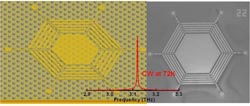A new level for continuous-wave terahertz lasers

<br>
Since the first quantum cascade (QC) laser was demonstrated in 1994 and implemented in THz regime in 2002, they have become one of the most important solid state light sources in this frequency range.
The metal-metal (MM) waveguide was a key improvement in applying the quantum cascade concept from mid-infrared to THz range, allowing for a sub-wavelength field confinement. Nevertheless, this confinement leads to a highly divergent beam from the facet. Different strategies like photonic crystal (PhC) or metallic grating distributed feedback (DFB) patterning for in plane or vertical emission have been developed.
However, most of these progresses were demonstrated in pulsed operation mode. Continuous-wave (CW) operation performance is still limited and far from being optimized, despite the fact that it is of a crucial demand in astrophysics, biology, sensing, environmental and pollutant monitoring, or security screening.
Distributed feedback and PhC QC lasers are amongst the leading candidates in the field of semiconductor light sources with high performance CW and single mode operation in the THz frequency range. Absorbing boundary condition is a commonly used method to control the optical performance of a laser in double-metal confinement. However, this approach increases the total loss in the device and results in a large threshold current density, limiting the CW maximum output power and operating temperature.
Swiss researchers now present a new approach: they replaced the loss type boundary conditions by a second order Bragg grating which can diffract TM polarized in-plane radiation at the required frequency into vertical emission. More importantly, instead of absorbing the radiation at the boundary, to ensure the single mode operation this Bragg grating scatters them into desired vertical emission. A large pumping efficiency with better heat flow dissipation is achieved: The new design enables CW operation that is significantly improved in terms of maximum output power and Tmax.
The team from Ecole Polytechnique Fédérale de Lausanne (EPFL) and Eidgenössische Technische Hochschule Zürich (ETHZ) report single mode surface emission with several milliwatts output power at 3.12 THz. A maximum operation temperature (Tmax) of 100 K was achieved. The scientists were able to demonstrate a highly collimated far-field pattern, which is an important step towards real world applications.
Thanks to the scalability of PhCs, their new design can be applied throughout the entire THz wavelength range, especially for longer wavelengths. The researchers are convinced that a variety of real applications of the CW operation THz light sources can be achieved in the future with optimized slope efficiencies and remarkable output powers above the liquid nitrogen temperature.
(Text contributed by K. Maedefessel-Herrmann)
Houdré, R., et al., Laser Photonics Rev., 7(5), L45-L50 (2013); DOI 10.1002/lpor.201300035
http://onlinelibrary.wiley.com/doi/10.1002/lpor.201300035/abstract
Laser & Photonics Reviews is an international journal which covers the current range of laser physics and photonics, both theoretical and experimental, from recent research to specific developments and novel applications. The journal publishes Review Articles, Original Papers and Letters. Latest Journal Impact Factor (2012): 7.976 (ISI Journal Citation Reports 2012)
Media Contact
More Information:
http://www.wiley.comAll latest news from the category: Process Engineering
This special field revolves around processes for modifying material properties (milling, cooling), composition (filtration, distillation) and type (oxidation, hydration).
Valuable information is available on a broad range of technologies including material separation, laser processes, measuring techniques and robot engineering in addition to testing methods and coating and materials analysis processes.
Newest articles

High-energy-density aqueous battery based on halogen multi-electron transfer
Traditional non-aqueous lithium-ion batteries have a high energy density, but their safety is compromised due to the flammable organic electrolytes they utilize. Aqueous batteries use water as the solvent for…

First-ever combined heart pump and pig kidney transplant
…gives new hope to patient with terminal illness. Surgeons at NYU Langone Health performed the first-ever combined mechanical heart pump and gene-edited pig kidney transplant surgery in a 54-year-old woman…

Biophysics: Testing how well biomarkers work
LMU researchers have developed a method to determine how reliably target proteins can be labeled using super-resolution fluorescence microscopy. Modern microscopy techniques make it possible to examine the inner workings…





















